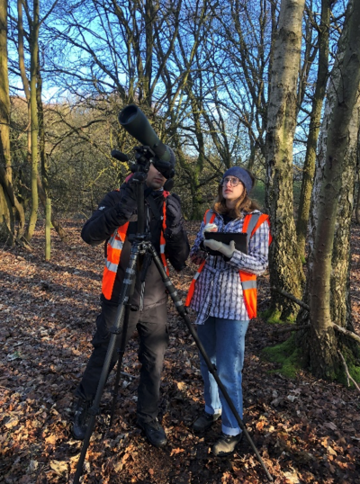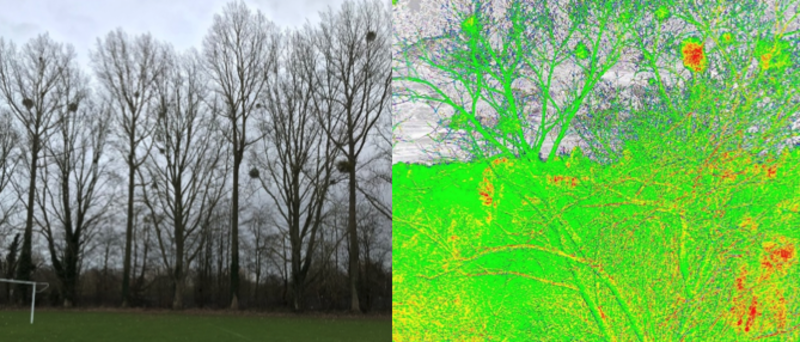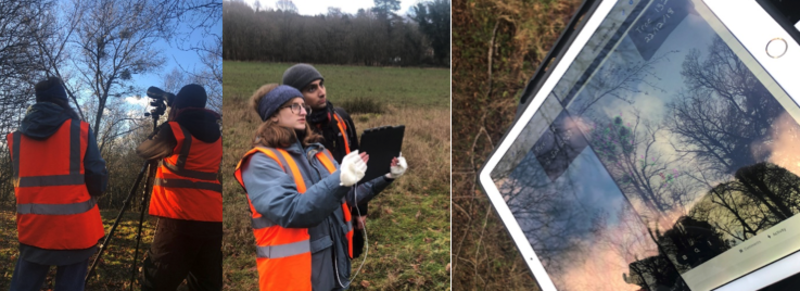Diaries of a mistletoe hunter
Scroll down for Afrikaans
[ENG] My name is Kyra and I’m in my final year of undergraduate studies at Bryn Mawr College in the US. I’m interested in ecology and philosophy of science, specifically in understanding how we can model biological complexity. I’ve been working with Rob on a mistletoe demography project for about a year now and I recently visited Oxford for two weeks to help with some of the fieldwork.

Fig. 1 Kyra (right) and Yash (left) in the field surveying mistletoe
The cool thing about mistletoe—and one of the reasons it’s important to study—is that it’s hemi-parasitic. This means that the plant can obtain resources both from photosynthesis and from its host tree. At the moment there’s not a lot of data on parasitic plants, but they’re important to understand because their life history strategies may differ from non-parasitic species. For example, because mistletoe plants don’t need to invest as much energy into a root system to obtain water, we might expect them to have more energy to invest in reproduction than non-parasitic plants. The main hypothesis we’re investigating in this study is that mistletoe will demonstrate weaker trade-offs in reproduction and survival than non-parasitic plants.

Fig. 2 Left: Stand of trees that are hosts to mistletoe (the dense ball-like structures on the branches). Right: A hypespectral UAV image of branches with mistletoe (red = photosynthetically active).
Investigating this hypothesis involves a lot of tromping around in the woods with various pieces of expensive equipment. On a typical day in the field, Rob, Yash and I carried two drones, two scopes, at least one tripod, a camera, and two iPads out into the woods looking like a group of over-prepared hikers. Once we arrived at a tree, we would take a picture of it from the same spot the picture was taken last year. This makes it easier to tell which mistletoes have died and which are still on the tree. After we took pictures with the iPad, camera, and drone, we would use the scopes to identify whether the mistletoes had fruit on them to determine whether they were reproductive. Finally, we would scan the tree to find new recruits—young plants that could have only a few leaves.

Fig. 3 Left: Kyra and Yash using the scope to identify fruit on mistletoe. Middle: Kyra and Yash looking at pictures from the previous year to find the same spot to re-take pictures. Right: Using the iPad two compare a tree form two different years to see how mistletoe presence has changed.
Back at Bryn Mawr I spend a lot of time in the lab staring at the pictures from the field. Using the software ImageJ, I can measure the relative growth of the plants from the pictures we take each year. For the past year I’ve been using these images to gather information on the growth, survival, and reproduction of each individual mistletoe over the course of several years. I’ve started to use these data in integral projection models (IPMs) that will help us to understand the demography of these populations.
One of my favorite parts of doing fieldwork this year was realizing how well I’ve gotten to know each of the host trees. Just from looking at the branching patterns and distribution of mistletoe, I can tell you the ID number of almost all 25 of them. I even have some favorite mistletoe plants (mistletoe number 38 on Tree 128 is especially cute). Spending so much time looking at mistletoe plants on a computer screen has helped me to find even very small plants when I’m out in the field. It’s a very odd skill, but one that I’m very proud to have.
Written by Kyra Hoerr
[AFR] My naam is Kyra en ek is in my finale jaar van voorgraadse studies by die Bryn Mawr College in die VSA. Ek stel belang in ekologie en filosofie van wetenskap, spesifiek om te verstaan hoe ons biologiese kompleksiteit kan modelleer. Ek werk al ongeveer 'n jaar saam met Rob aan 'n mistel-demografie-projek, en onlangs het ek Oxford vir twee weke besoek om te help met die veldwerk.
Die lekker ding van mistel - en een van die redes waarom dit belangrik is om te bestudeer - is dat dit hemi-parasities is. Dit beteken dat die plant hulpbronne kan verkry uit fotosintese en van sy gasheerboom. Op die oomblik is daar nie baie inligting oor parasitiese plante nie, maar dit is belangrik om te verstaan, want hul lewensgeskiedenisstrategieë kan verskil van nie-parasitiese spesies. Omdat mistel plante, byvoorbeeld, nie soveel energie in 'n wortelstelsel hoef te belê om water te verkry nie, kan ons verwag dat hulle meer energie het om in reproduksie te belê as nie-parasitiese plante. Die belangrikste hipotese wat ons in hierdie studie ondersoek is dat mistel swakker inruilings in voortplanting en oorlewing sal toon as nie-parasitiese plante
Ondersoek na hierdie hipotese behels baie rondhardloop in die bos met verskillende stukke duur toerusting. Op 'n tipiese dag in die veld het ek, Rob en Yash twee drones, twee teleskope, ten minste een driepoot, 'n kamera en twee iPads in die woud uitgedra soos 'n groep voorbereide stappers. Nadat ons by 'n boom gekom het, neem ons 'n foto daarvan op dieselfde plek as wat ons die voorige jaar die fotot geneem het. Dit maak dit makliker om te sien watter mistel dood is en wat nog op die boom is. Nadat ons foto's met die iPad, kamera en drone gevat het, gebruik ons die teleskope om te bepaal of die mistel vrugte dra, om vas te stel of hulle voortplant. Laastens, het ons die boom skandeer om nuwe rekrute te vind - jong plante wat slegs 'n paar blare het.
Terug by Bryn Mawr spandeer ek baie tyd in die laboratorium en kyk na die foto’s van die veld. Met behulp van die sagteware ImageJ, kan ek die relatiewe groei van die plante meet vanaf die foto's wat ons elke jaar neem. Die afgelope jaar gebruik ek hierdie beelde om inligting oor die groei, oorlewing en voortplanting van elke individuele mistel in die loop van 'n paar jaar te versamel. Ek het hierdie data begin gebruik in integrale projeksiemodelle (IPM's) wat ons sal help om die demografie van hierdie bevolkings te verstaan.
Een van my gunsteling gedeeltes van veldwerk hierdie jaar, was om te besef hoe goed ek al die gasheerbome leer ken het. Net deur die vertakkingspatrone en verspreiding van mistel te kyk, kan ek u die ID-nommer van byna al 25 daarvan vertel. Ek het selfs 'n paar gunsteling mistelplante (mistel nommer 38 op boom 128 is veral oulik). Al die tyd wat ek gespandeer het om na die mistelplante op 'n rekenaarskerm te kyk, het my gehelp om selfs baie klein plante te vind as ek in die veld is. Dit is 'n baie vreemde vaardigheid, maar ek is baie trots daarop.
Vertaal deur Jacques Deere
[Translated by Jacques Deere]



